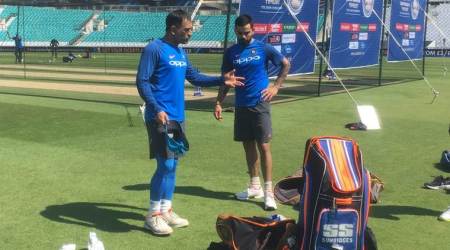 Post thigh surgery, Rohit Sharma has rediscovered his balance. (Source: Reuters)
Post thigh surgery, Rohit Sharma has rediscovered his balance. (Source: Reuters)
Minutes after he completed his 11th ODI ton, Rohit Sharma was summoned for a batting master-class in the company of former England openers Michael Atherton, Robert Key and Ian Ward. Still donning his pads and clearly tired, Rohit was shown various freeze frames of some of the shots he played during his match-winning knock against Bangladesh.
One image in particular caught the attention of the three cricket pundits and they began gushing over how balanced the Indian opener was at the point bat was about to connect with ball, with Ward calling it “perfection” and insisting that it “couldn’t be any better”. Rohit smiled sheepishly, agreeing with them before talking about how his focus in terms of batting technique over the last few years has been incessantly based on “balance”.
He also revealed how his promotion in the order during the last edition of the Champions Trophy had allowed him to do so, and also subsequently transformed his career. “When you’re walking out in the middle-order, the focus is always on scoring runs and how you’re going to do that. But when you’re opening, you can focus a lot more on your technique and work on factors like balance,” he told them. It was a poignant point.
“Balance”, interestingly, had been an issue for Rohit in the IPL, his first outing following the thigh surgery that kept him out for nearly six months. Often he would fall over while defending against balls that were angled into him, from leg-spinners in particular and be bowled or lbw.
Zing, back in his drive
The sudden lack of balance also ensured he wasn’t driving with his usual punchiness, at least during the first half of the IPL season, and not getting into a great position while playing the whippy shots on the on-side either. Not surprisingly, he ended up having the quietest IPL season of his career. Perhaps it had something to do with the fact that he was batting in the middle-order for Mumbai Indians, where he kept walking into situations where the onus was always on scoring quick runs.
And there were some worries about Rohit’s form coming into the Champions Trophy as a result. But here he was back to opening the innings, and back to being able to focus on his technique for longer periods. But he also spent more time than any of the other Indian batsmen in the nets during their initial few practice sessions in England.
In one particular indoor net session at Edgbaston, he spent nearly an hour-and-a-half with Sanjay Bangar with the batting coach asking him to try being more upright in his stance and open it up a tad so that the head was clearly above the front-toe, and the balance perfect. He even summoned one of the support staff members to shoot this particular session, probably so that he could just use it as a revision tool.
On Thursday, the pitch was flat and Rohit’s balance was perfect, as revealed later by Ward & Co. Even though the Bangladeshi pacers for some reason preferred pitching the ball short to him constantly—even his century came off an attempted hook off Mustafizur Rahman—he did unleash a couple of Rohit-esque drives, the aesthetic value as always at a premium, with the bat and body both flowing perfectly towards the ball.
It wasn’t surprising either that he would want to fill his boots up here, considering that he’s been rested for the West Indies tour later this month. And yes, like with most Rohit Sharma knocks of note in ODI cricket, the English cricket pundits weren’t the only ones gushing over his stroke-play at Edgbaston, with or without a freeze-frame.

